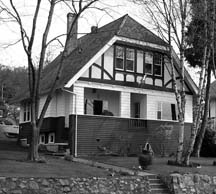Architecture and buildings
Townsite a treasure trove for fans of the period
By Susan Clark
As an amateur historian I enjoy walking around the Powell River Townsite. As I walk, I entertain myself by trying to figure out the ideas behind the buildings.
I get the impression that the design of the town was intended to be a visual representation of the modern and successful business on which it was founded. The Arts and Crafts Movement, which in 1910 was just beginning its prominence in North America, was ideal for this purpose. As the town grew, the latest trends continued to be adopted.
An early example of this thinking is the hospital. Completed in 1913 it copied the design of the commercial buildings in the Exchange District of Winnipeg, then one of the fastest growing cities in the whole of North America. Winnipeg had imported architects from Chicago, the commercial hub of the United States and home of the first American skyscrapers. I suspect that Brooks Scanlon wanted to imply the same power, excitement  and prosperity for Powell River.
and prosperity for Powell River.
Ten years later the town was still on the leading edge of design. Starting in 1923 "middle management" houses were erected along Marine Avenue. What stands out for me are the distinctive roof lines of these homes. The upper portion of the front gables have been "clipped" off and replaced by a small hipped roof.
This roof line was a revival of a medieval European style that became popular in Arts and Crafts houses in the 1920s.
As Marine intersects with Ash the commercial buildings take over. A favourite of mine is the Federal building. It is in the Streamline Moderne style, a late branch of Art Deco, which came out of the new scientific principles of design in the 1930s. Cars, trains and aircraft of the era all had aerodynamic lines that are reflected in the flat roof, horizontal lines and brick work. The austerity of the Depression is signified by its lack of ornate decoration.
In comparing the Arbutus apartments with the sleek lines of the Federal building one might think the progressive design ethic was abandoned. In fact, it follows a usage then current in other company towns. Picturesque architecture was an amalgamation of styles from the past, often Victorian, with which many of the European immigrants would be familiar. While certainly comforting for homesick newcomers, social historians have speculated that the intention was to evoke an old world social order, where loyalty to the lord of the manor, or in this case the company, was predominant.
In this company town all roads lead to the paper mill. The business that founded the town is still in operation and the town still functions in its original purpose. This fact is what makes the Townsite significant, above and beyond the social and architectural history. Earlier forms of company towns in Europe have been given World Heritage designation, yet exist only as museums, or have lost their industrial component. I can't help feeling we deserve a wider recognition.
I have only been able to mention a few buildings, but I hope I have inspired you to take a walk through the Townsite. If you would like to learn more, the Townsite Heritage Society leads guided walks that are both interesting and entertaining.